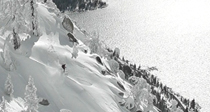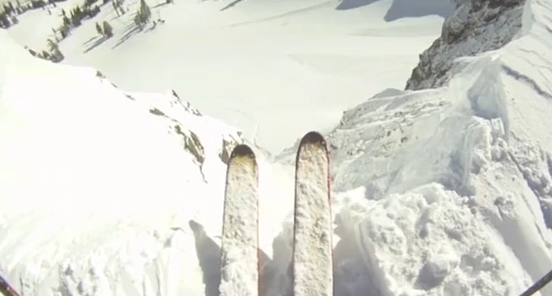The Bomb Squad: A Day in the Boots of the Squaw Valley’s Snow Safety Patrol
By
March 2006
 It’s Friday, March 3, 2006 and a storm has been building off the Pacific for four days.
It’s Friday, March 3, 2006 and a storm has been building off the Pacific for four days.
The lift line at the KT-22 chair starts forming almost three hours before the lift opens. Skiers in full-face helmets and fat skis peer up at hucker-friendly coastal snowpack sticking to everything, but most notably to the Fingers—a 40-foot diving board in full view of the lift line. It’s a powder day at Squaw.
Today is the most powerful weather event of the season and the locals know it. Many of them also know that all that new snow sits stacked atop a four-day-old rain crust—textbook conditions for one mother of an avalanche cycle. But only a handful know that a dedicated, 32-person snow safety team started their day six hours before the lifts open, scrutinizing weather maps, gearing up, shoveling out, assessing, ski cutting and throwing bomb after bomb after bomb to make the mountain safer.
If it sounds like a military operation, that’s because it virtually is, from strategic planning, detailed logistics, deployment of highly coordinated patrol units, and the use of live ammo. The following is fifteen hours in the lives of the Squaw snow safety team.
Friday, March 3, 2006
0300: Will Paden,
0310: Paden, age 36, calls grooming director Tom Boxler, who’s been combing Squaw’s slopes all night and has a good feel for the stability of the snow. Boxler reports that it’s still dumping and that Headwall Face slid naturally to Mambo Meadows. It’s going to be a big day.
0330: Paden phones avalanche control director, Bob Cushman. They’ll need all of their team’s human and explosive resources to open the mountain by 0900. They set the dialing tree in motion, rousing all 32 patrollers from bed.
0445: Sleepy patrollers shovel out driveways and navigate Subarus through snowy darkness. Two arrive early and drive a snowcat to collect explosives from the secured magazine in the meadow, 1,400 feet from the Patrol Room.
0520: Patrollers like rookie Will Brown, 44-year veteran Wes Schimmelpfennig, and Matt Calcutt file into the Patrol Room. The avalanche control command center is a crowded, dank space, lined with wooden lockers and benches littered with gear. Avy dogs scamper about. Patrollers buckle boots, strap on beacons, and load packs. They stuff their jackets full of crimpers (for cutting fuses) igniters and PowerBars.
0545: Assistant patrol director Curtis Crooks reviews route assignments with the team. Today, six teams of two will tackle 23 control routes on KT-22, Red Dog, the Slot, Headwall Face, Tower 16, and
0600: Eric Lowell, 32, heads out to lead a route. Lowell had the drive, references, and a lucky connection to break into Squaw’s tightly knit crew three years ago. He also nailed his hour-long interview with Crooks and Cushman. “Everything I learned about avalanche control, I learned at Squaw,” says Lowell. On his first day, he took his “rookie walk” with Paden, where he armed shots, assembled a cap and fuse, clipped a fuse, and put on an igniter. Squaw later sent him to Avalanche I class and provided problem-oriented beacon training. Last season Lowell got his blaster’s license and earned a “K” designation on two routes. He doesn’t plan to leave the Squaw patrol anytime soon.
0610: “Today is the biggest avalanche hazard day we’ve seen all season,” reports Paden as he takes over the meeting. He pulls down a projector screen and shows a rainbow-colored weather map and warns of a deep weak layer in the snowpack. It will take 16 cases of hand charge explosives to control the slopes today—the most the team has used all season. Squaw Valley is one of the single largest users of high-charge explosives, even more than most mining operations. Today, 30 patrollers will toss almost 500 hand charges—880 pounds and almost $3,000 worth—of Ammonium Nitrate emulsion, the same explosive used in the 1993 Oklahoma City bombing.
0620: Paden ends the meeting and suits up his third-generation avalanche dog, Roscoe, in a harness-vest that matches Paden’s jacket: Red with a white cross. Two other dogs, Boon and Jonson, flap their tails. The stereo cranks out a song written and sung by ex-patroller Peter Charles about Squaw’s patrol team, to the tune of Johnny Cash’s “In the Jailhouse Now.”
0630: Dawn. Patrollers load cases of unarmed bombs into their packs and onto the snowcats that will crawl to the upper mountain. Patrollers in groups of six click in, grab a long rope and a snowcat tows them through powder to the base of Red Dog and KT-22.
0640: The corral is deserted, except for a lift-op and two eager locals waiting for first chair, almost two and a half hours before it will open. Over the next two hours, the KT line will swell beyond the ropes. When the upper mountain is closed because of high winds and avalanche danger following a storm, the default ski zone is the 1,500 vertical feet that KT and Red Dog access. On days like this, skiers will race for freshies or first boosts off the Fingers, the prominent cliff band right under the lift. The line erupts as veterans like Scott Gaffney or Shane McConkey hit a drop. Still, the crowds in the KT line are notoriously pushy. Elbows will fly as skiers squeeze through the choke and onto the chair.
0645: Roscoe leaps up next to Paden on a KT chair. Roscoe is assigned to KT’s top shack, and the other avy dogs are spread out at of one of five complexes at the top of Headwall, Shirley Lake, Silverado and Red Dog. If there’s a post-control release, there’s always a dog ready to search. Post-control avalanches don’t happen often, but dogs were called out last season when Headwall Face unexpectedly slid 30 inches deep at 2 p.m., burying four skiers who were all rescued by patrol. Keeping rescue dogs trained is a huge commitment, but if a skier is buried without a beacon, a dog is the best way to find him.
0655: The first patrol crew gets off the chair. All 12 pack into the summit patrol shack and form a bomb assembly line. Laying out bright yellow powder cartridges, John “Wegy” Weglarz pokes a hole in each one, Brown inserts an orange safety fuse and blasting cap, and Paden duct tapes the unit together. Everyone stuffs bombs into packs, clicks in to skis, and fans out along the ridge. It’s dumping again.
0720: “Fire in the hole!” screams Paden as he cuts the fuse off the first charge, pulls off the igniter, and lobs the bomb over the ridge into GS Bowl. He tosses another bomb. After 90 seconds, the first one explodes. Then another. Paden’s an expert at keeping track of bombs. When one doesn’t detonate, patrol has to close the area and wait an hour before they can retrieve it. Though the 2-pound bombs pack has a detonation velocity of 16,700 feet/second when ignited, they are fairly stable. “You could fire a 20 caliber bullet into the cartridge, and it probably won’t go off,” says Crooks.
0730: BOOM! Across the valley, Alpine Meadows patrol fires their howitzer. Because Squaw is linked by a series of ridgelines, patrol can access all potential start zones on foot or skis. This allows them to avoid the hassle, danger, and expense of heavier artillery. They strategically toss hand charges instead, based on decades of experience with avalanche start zones. Shot placement zones are marked on photos in the patrol room but exact placement is more art than science, changing with the season and the snowpack.
0745: “On days like today we call it our Eiger,” yells a passing patroller as Paden and Brown front point their ski boots up the backside of Eagle’s Nest, one of KT’s showcase lines with pitches up to 65 degrees. Accessed by a sheet of steep, rock-speckled ice, the footing is precarious. But they summit safely and stop to pet a wooden duck perched in a tree—a Squaw ritual that ensures continued snowfall.
0820: Clouds of smoke, snow, and debris hang in the air as charges explode all around. Paden breaks trail through deep drifts, deliberately slicing snow off the slope. Ski cutting is an integral part of avalanche control, performed after most of a route has been bombed. Deciding where to ski cut is a judgment call, but patrol never ski cuts a zone that could harbor a large avalanche. Rather, ski cutting is used to push loose snow off specific, potentially dangerous and isolated pockets. Though he has a good idea of what might slide and where, Paden never knows exactly until he’s out there feeling it with his skis. He ski cuts a few times, then rips powder turns to the bottom.
0830: The KT lifeline is swelling. Paden zips around the crowd and loads KT for another round of ski cutting and a final cleanup. For once, “cleaning-up” is fun.
0900: Release the hounds! The avalanche control team drops the rope so all of Squawllywood can get after it.
0907: Carcasses fly off the Fingers to wild applause from the lift line.
0910: The snow-covered Gore-Tex and iced-over beards cycle back for seconds, and patrol couldn’t be happier about it. “After control on a heavy snow day, we’re hoping for a big crowd at KT because ski compaction is the best avalanche control,” says Crooks. “We can’t throw bombs when the lift is open. If it’s snowing 1-3 inches an hour and we have a small crowd, we have to close the lift and start again the next morning.”
0915: Paden rides KT again and helps dig out buried signs and ropes that mark closures or cliff areas.
1400: It’s still snowing. The sky is forecasted to clear by morning and that means Paden will need to open areas of the upper mountain like Granite Chief and Silverado. They’re already under up to five feet of new. Patrollers start assembling bombs for tomorrow.
1600: The sweep is on and Paden joins all available forces to check for straggling skiers.
1645: Fatigued patrollers return to the patrol room. Paden conducts a debriefing on the day’s avalanche activity, explains what can be expected for tomorrow, and heads to the bar for a beer.
1750: Paden heads home as darkness descends, knowing that he’ll be back before sunrise. It dumps all night. Clearly, the wooden duck is working its magic.




Recent Comments